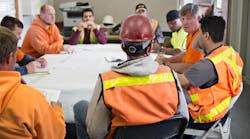Cleveland, Ohio, is home to the largest contingency of Slovenians outside of their home country. My Slovenian family left former Yugoslavia to escape communism and find opportunity.
My maternal grandparents, mother and aunt arrived in Cleveland in 1970 with nothing to their names. They didn’t know English. My aunt and mother went to school where they had to assimilate with classmates, and my grandparents set out to work in factories.
Many Eastern Europeans (Croatians, Serbians, Bosnians…etc.) who reside in Cleveland have similar stories. They faced tremendous cultural barriers. They didn’t ask questions. They just set to work and followed commands.
While fighting to survive and build a better life, safety and personal protective equipment was the last thing on their minds. While I cannot find evidence of specific statistics related to this specific demographic, I have seen more than my fair share of missing fingers and hearing aids.
The story of a foreign-born employee who was crushed by a press was just part of normal conversation at the dinner table. Injuries were just taken as a risk equated to the job, something as commonplace as falling from a jungle gym. The struggle to survive and create a better life for the family and future generations was the number one priority.
The U.S. Census Bureau estimates that more than 350 languages are spoken in the United States. It’s no surprise that the task a safety professional takes on to communicate with a foreign-born population is a complex one to navigate. Employers face multiple cultural barriers when communicating safety practices to foreign-born workers.
At Safety 2019, Carmen Julia Castellon, health and safety specialist for U.S. Cellular, explained the difficulties employers and safety managers face with a growing foreign-born Latino workforce in particular. Pew Research Center indicates that Latinos accounted for 52% of all U.S. population growth between 2008 and 2018. The share of the demographic’s U.S. population grew to 18% from 16%.
“There is a lack of communication between foreign-born Latinos, their superiors and even their coworkers because of limited language capabilities,” she said.
When it comes to safety, the availability of Spanish training manuals, videos and other materials presents a challenge, often causing a communication breakdown. Castellon advised that instead of dictating what needs to be done, safety professionals can act as cultural leaders and take time to understand the population through working to break cultural barriers; providing step-by-step direction and detailed explanations; giving the employee authority to stop if unsafe work is observed; and creating an inclusive and safe environment for a multicultural workforce.
“We need to give them the power and empower them to say ‘this is not safe’ without fear of retaliation,” she said.
Opening lines of communication with foreign-born workers can be extremely difficult. I previously wrote for a publication whose audience was largely Chinese. What worked for me is answering the six questions in my Journalism 101 class that would create a story with the most important information: Who, What, Where, When, Why and How?
Who is the worker? Take into account their background for differences in social norms, language and cultural barriers.
What are you trying to communicate? Was this a near-miss? Basic training concepts? The importance of why the worker needs to wear gloves?
When is the best time to communicate this message? Show them how this safety measure relates to their task as they are completing it if possible.
Where? Sometimes a group session isn’t the best place where everyone else may already understand the concept.
Why is this rule or procedure important? Get to know the worker on a personal level and explain how an incident might affect their family and life.
How are you going to communicate this point? Stay away from buzzwords or slang. Visual aids work well, but stay away from only using signage.
To help someone understand and retain the knowledge we need, it helps to provide as much information as possible in a succinct manner. Foreign-born workers have a fantastic work ethic at the expense of themselves. Safety professionals need to build trust and give them the confidence that they will still be viewed as a dedicated worker if safety is held at the same level as productivity. That trust can be built by beginning to understand the who, what, when, where and why and how of communication.
